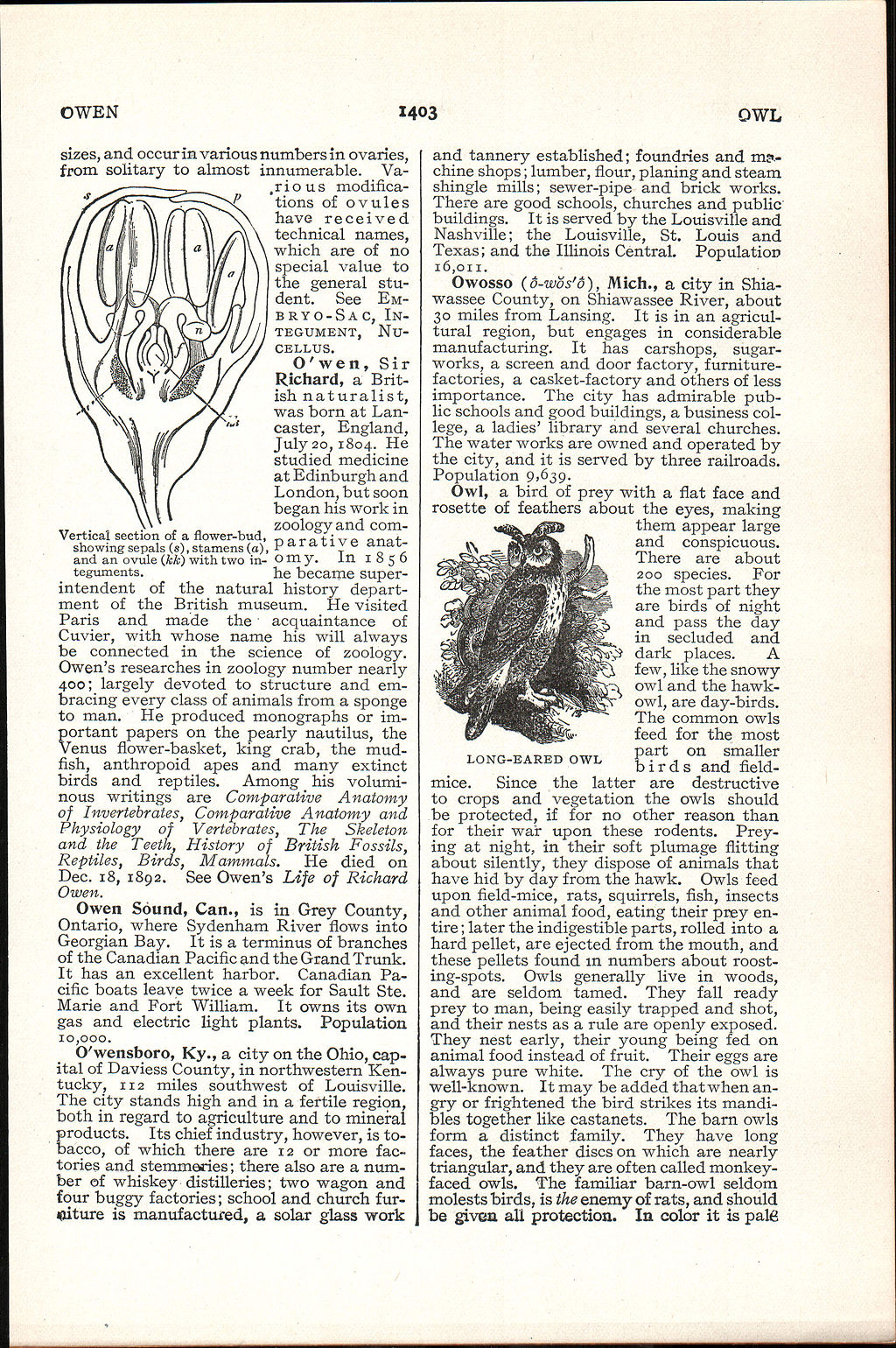OWEN
1403
OWL
sizes, and occur in various numbers in ovaries, from solitary to almost innumerable. Various modifications of ovules have received technical names, which are of no special value to the general student. See EMBRYO-SAC, INTEGUMENT, Nu-
CELLUS.
O'wen, Sir Richard, a British naturalist, was born at Lancaster, England, July 20,1804. He studied medicine at Edinburgh and London, but soon began his work in zoology and com-parative anatomy. In 1856 he became superintendent of the natural history department of the British museum. He visited Paris and made the acquaintance of Cuvier, with whose name his will always be connected in the science of zoology. Owen's researches in zoology number nearly 400; largely devoted to structure and embracing every class of animals from a sponge to man. He produced monographs or important papers on the pearly nautilus, the Venus flower-basket, king crab, the mudfish, anthropoid apes and many extinct birds and reptiles. Among his voluminous writings are Comparative Anatomy of Invertebrates, Comparative Anatomy and Physiology of Vertebrates, The Skeleton and the Teeth, History of British Fossils, Reptiles, Birds, Mammals. He died on Dec. 18, 1892. See Owen's Life of Richard Owen.
Owen Sound, Can., is in Grey County, Ontario, where Sydenham River flows into Georgian Bay. It is a terminus of branches of the Canadian Pacific and the Grand Trunk. It has an excellent harbor. Canadian Pacific boats leave twice a week for Sault Ste. Marie and Fort William. It owns its own gas and electric light plants. Population 10,000.
O'wensboro, Ky., a city on the Ohio, capital of Daviess County, in northwestern Kentucky, 112 miles southwest of Louisville. The city stands high and in a fertile region, both in regard to agriculture and to mineral products. Its chief industry, however, is tobacco, of which there are 12 or more factories and stemmeries; there also are a number of whiskey distilleries; two wagon and four buggy factories; school and church fur-$iture is manufactured, a solar glass work
and tannery established; foundries and machine shops; lumber, flour, planing and steam shingle mills; sewer-pipe and brick works. There are good schools, churches and public buildings. It is served by the Louisville and Nashville; the Louisville, St. Louis and Texas; and the Illinois Central. Population 16,011.
Owosso (6-wbs'd), Mich., a city in Shia-wassee County, on Shiawassee River, about 30 miles from Lansing. It is in an agricultural region, but engages in considerable manufacturing. It has carshops, sugar-works, a screen and door factory, furniture-factories, a casket-factory and others of less importance. The city has admirable public schools and good buildings, a business college, a ladies' library and several churches. The water works are owned and operated by the city, and it is served by three railroads. Population 9*639.
Owl, a bird of prey with a flat face and rosette of feathers about the eyes, making them appear large and conspicuous. There are about 200 species. For the most part they are birds of night and pass the day in secluded and dark places. A few, like the snowy owl and the hawk-owl, are day-birds. The common owls feed for the most part on smaller birds and field-mice. Since the latter are destructive to crops and vegetation the owls should be protected, if for no other reason than for their war upon these rodents. Preying at night, in their soft plumage flitting about silently, they dispose of animals that have hid by day from the hawk. Owls feed upon field-mice, rats, squirrels, fish, insects and other animal food, eating tneir prey entire ; later the indigestible parts, rolled into a hard pellet, are ejected from the mouth, and these pellets found in numbers about roost-ing-spots. Owls generally live in woods, and are seldom tamed. They fall ready prey to man, being easily trapped and shot, and their nests as a rule are openly exposed. They nest early, their young being fed on animal food instead of fruit. Their eggs are always pure white. The cry of the owl is well-known. It may be added that when angry or frightened the bird strikes its mandibles together like castanets. The barn owls form a distinct family. They have long faces, the feather discs on which are nearly triangular, and they are often called monkey-faced owls. The familiar barn-owl seldom molests birds, is the enemy of rats, and should be given, all protection. la color it is pale
LONG-EARED OWL
Vertical section of a flower-bud, showing sepals (s), stamens (a), and an ovule (kk) with two integuments.
